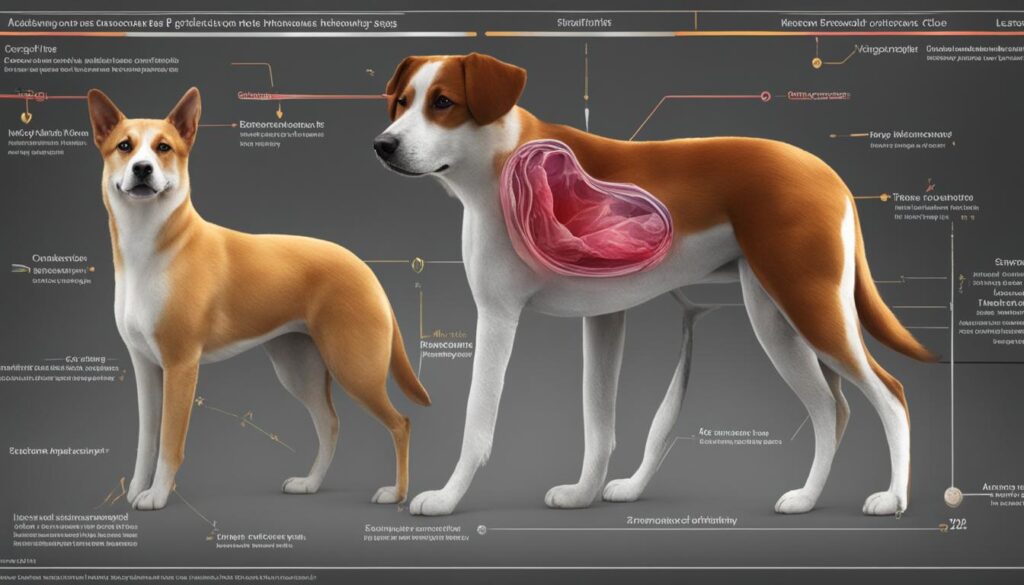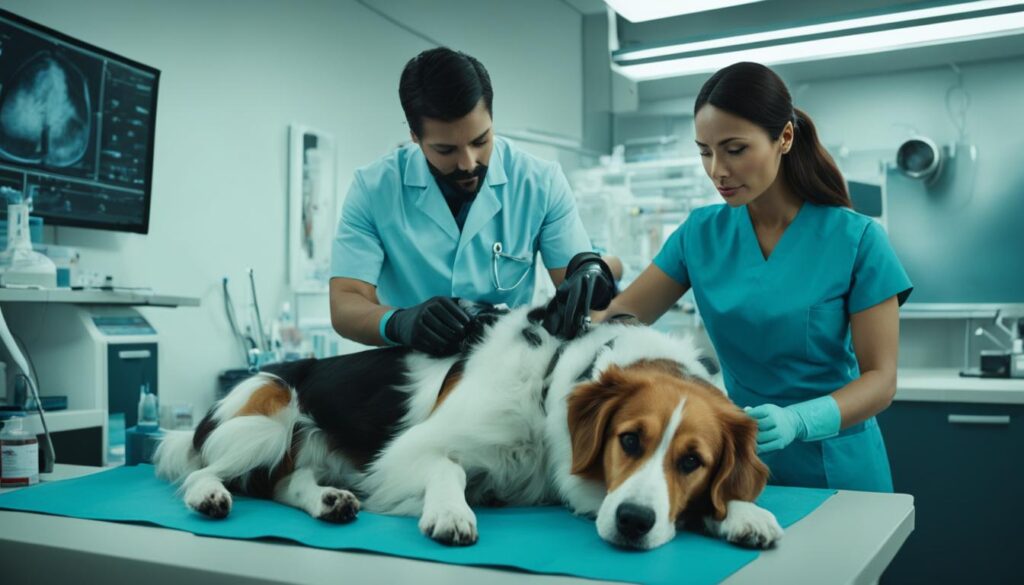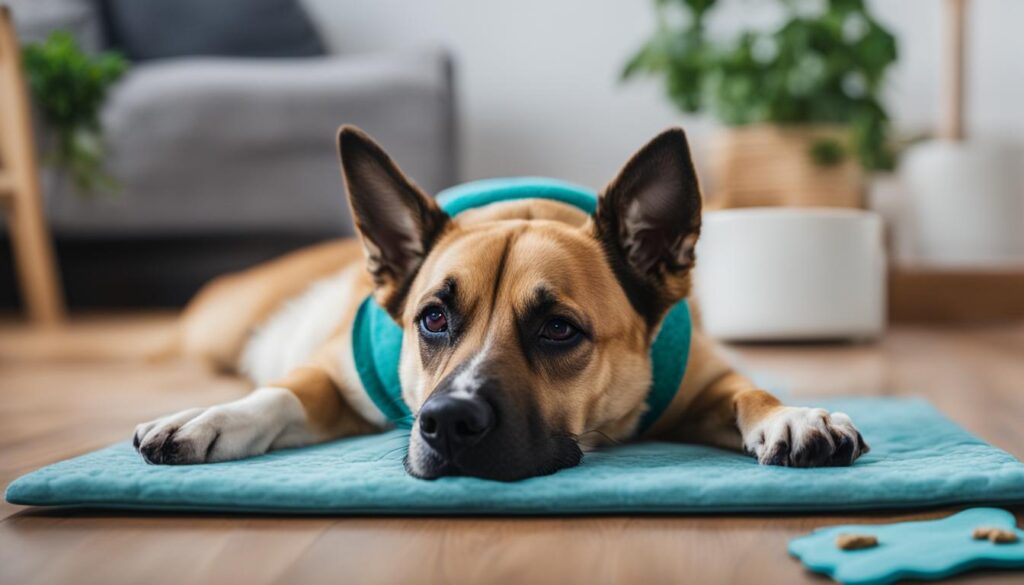As a dog owner, it’s natural to wonder if your furry friend experiences discomfort during their heat cycle. Just like humans, female dogs go through a reproductive cycle, known as the heat cycle or estrus. This cycle consists of four stages: Proestrus, Estrus, Diestrus, and Anestrus.
While dogs cannot communicate if they have period cramps like humans do, there are certain signs that suggest they may experience some level of discomfort. These signs include lethargy, loss of appetite, restlessness, whimpering, panting, and other behaviors that indicate distress.
Providing your dog with comfort during her heat cycle is important. Creating a quiet and cozy space for her to rest, engaging in gentle exercise, and ensuring she stays hydrated can all contribute to her overall well-being. In cases where your dog’s discomfort is severe or if there are changes in her discharge, seeking veterinary care is crucial to her reproductive health.
In this article, I will delve deeper into the canine heat cycle, signs of period cramps in dogs, and strategies for managing your dog’s discomfort during this time. Let’s explore this topic to gain a better understanding of our canine companions’ reproductive health.
Key Takeaways:
- Female dogs go through a heat cycle, consisting of four stages: Proestrus, Estrus, Diestrus, and Anestrus.
- While dogs cannot communicate if they have period cramps, signs of discomfort may include lethargy, loss of appetite, restlessness, whimpering, and panting.
- Providing a comfortable environment, gentle exercise, and adequate hydration can help ease your dog’s discomfort during her heat cycle.
- It is important to seek veterinary care if your dog’s discomfort is severe or if there are changes in her discharge.
- Spaying is a consideration to manage heat cycles and should be discussed with a veterinarian.
Understanding the Canine Heat Cycle

The canine heat cycle, also known as estrus, is the period when a female dog is receptive to mating. It typically starts when the dog is between six to twelve months old and repeats every six months on average. The heat cycle has four stages: Proestrus, Estrus, Diestrus, and Anestrus.
- Proestrus: This is the first stage of the heat cycle and is characterized by a blood-tinged discharge. The female dog may also experience changes in behavior during this stage.
- Estrus: The second stage of the heat cycle is when the dog is ready to breed. The discharge becomes lighter in color during this stage.
- Diestrus: This stage signals the end of the mating period. The female dog may no longer be receptive to mating.
- Anestrus: Anestrus is a resting period before the next heat cycle begins. During this stage, the dog’s reproductive system is inactive.
Understanding the different stages of the canine heat cycle is essential for dog owners to effectively manage their pet’s reproductive health and behavior. It can also help identify signs of potential health issues or discomfort during this period.
Signs of Discomfort in Dogs in Heat

Dogs in heat may display various signs of discomfort, indicating that they are not feeling their best. These signs can include changes in behavior, lethargy, loss of appetite, restlessness, whimpering, panting, and overall signs of distress. While it’s uncertain if these signs are equivalent to human menstrual cramps, they do highlight the possibility that dogs experience discomfort during their heat cycle.
During heat cycles, dogs may exhibit lethargy and decreased activity levels. They may seem less interested in their usual activities or appear tired more frequently. Loss of appetite is another common sign, as dogs in heat may have reduced interest in food. Restlessness and increased anxiety are also typical indicators of discomfort during this time. Dogs may become more agitated, pace frequently, and struggle to settle down.
Whimpering and excessive vocalization are potential signs of distress. Dogs in heat may emit high-pitched sounds or whine more frequently. Panting is another common behavior, as dogs try to regulate their body temperature during the heat cycle. It’s important to note that overwhelming signs of distress, such as continuous and intense whimpering, should be evaluated by a veterinarian.
Managing Your Dog’s Discomfort During Her Heat Cycle

To help your dog stay comfortable during her heat cycle, it’s important to provide a quiet and cozy space for her to rest. This will allow her to retreat to a calming environment where she can relax and alleviate any discomfort she may be experiencing.
In addition to providing a quiet space, gentle exercise can also help ease your dog’s discomfort. Taking her for short walks or engaging her in low-impact activities can help relieve any tension or cramps she may be experiencing.
Staying hydrated is crucial during this time. Keep a fresh bowl of water available at all times, and encourage your dog to drink regularly. Proper hydration can help alleviate any dehydration-related symptoms and keep her overall health in check.
Many pet owners find that providing a warm blanket or heating pad can offer additional comfort to their dogs during their heat cycle. The warmth can help soothe any muscle cramps or discomfort she may be experiencing.
Remember to monitor your dog closely during her heat cycle, and if you notice any significant changes in behavior or if her discomfort becomes severe, it’s important to consult with your veterinarian for guidance and appropriate care.
| Managing Your Dog’s Discomfort | During Her Heat Cycle |
|---|---|
| Provide a quiet and cozy space | |
| Engage in gentle exercise | Walking and low-impact activities |
| Ensure she stays hydrated | Offer fresh water regularly |
| Provide a warm blanket or heating pad | Soothing comfort for muscle cramps |
When to Seek Veterinary Care During Your Dog’s Heat Cycle

During your dog’s heat cycle, it’s important to stay vigilant and monitor her behavior and health. While some level of discomfort is normal, significant changes in behavior or health should be taken seriously. If your dog is experiencing severe discomfort or if there are noticeable changes in her discharge, it is crucial to seek veterinary care promptly.
Changes in behavior may include restlessness, lethargy, loss of appetite, whimpering, or signs of distress. These can be indicators that your dog is in severe discomfort and may require medical attention.
Additionally, changes in discharge, such as a foul smell or a shift in color, could be signs of infection or other health issues. It is essential to have your veterinarian evaluate these changes to provide appropriate treatment.
Remember, as a responsible pet owner, your dog’s health and well-being should always be a priority. Consulting with a veterinarian will help ensure that your dog receives the necessary care and support during her heat cycle.
| Significant Changes in Behavior or Health | Severe Discomfort | Changes in Discharge |
|---|---|---|
| Restlessness | Panting | Foul Smell |
| Lethargy | Whimpering | Shift in Color |
| Loss of Appetite | Signs of Distress |
Understanding Dog Period Cramps

Female dogs can experience cramps during their heat cycle. While it’s not entirely clear if these cramps are equivalent to human menstrual cramps, some similarities in behavioral and physical changes suggest that dogs may experience discomfort during this time.
During a dog’s heat cycle, hormonal changes occur that prepare the body for potential pregnancy. These changes can lead to cramping-like sensations in the reproductive organs, similar to how human women experience cramps during their menstrual cycle. However, since dogs cannot communicate their pain directly, it’s difficult to determine the exact level of discomfort they may be experiencing.
One similarity between dog period cramps and human menstrual cramps is the presence of behavioral changes. Just like some women may become irritable or less active during their period, female dogs in heat may exhibit restlessness, whimpering, and signs of distress. They may also become more lethargic, lose their appetite, or pant excessively.
Physical changes can also indicate discomfort during a dog’s heat cycle. Some dogs may have a swollen vulva, increased urination, or changes in their discharge. It’s important to note that any significant changes in discharge, such as a foul odor or a shift in color, should be brought to the attention of a veterinarian as they may indicate an infection or other underlying health issue.
Understanding and recognizing these signs of discomfort is crucial for pet owners. Although dog period cramps may not be identical to human menstrual cramps, they can still cause discomfort and distress in your furry companion. Providing a comfortable environment, offering gentle exercise, and ensuring your dog stays hydrated can help alleviate some of the discomfort she may be experiencing during her heat cycle.
It’s important to remember that each dog is unique, and their experience of cramps during their heat cycle may vary. If you notice your dog exhibiting severe discomfort or if her behavior deviates significantly from her normal self, it’s recommended to consult with a veterinarian. They can provide further guidance and recommend appropriate treatments or medications to manage your dog’s discomfort effectively.
Relieving Dog Period Cramps

When your dog is experiencing period cramps, there are several methods you can try to help alleviate her discomfort. It’s important to note that every dog is different, and what works for one may not work for another. If your dog is in pain, it’s always best to consult with a veterinarian before attempting any new treatments or medications.
1. Massaging Your Dog’s Abdomen
Gently massaging your dog’s abdomen can help relieve cramps and promote relaxation. Start by using gentle circular motions and gradually increase the pressure if your dog tolerates it. This gentle massage can help stimulate blood circulation and ease muscle tension.
2. Offering a Heating Pad
A heating pad can provide soothing warmth to your dog’s abdomen, helping to alleviate cramps. Make sure to set the heating pad on a low setting and cover it with a towel or blanket to avoid direct contact with your dog’s skin. Always supervise your dog when using a heating pad to prevent burns.
3. Giving Small Amounts of Ginger
Ginger has natural anti-inflammatory properties and can help reduce pain and inflammation associated with period cramps. You can give your dog small amounts of fresh or powdered ginger mixed with her food. Start with a small quantity and monitor your dog’s response. If she shows any signs of discomfort or adverse reactions, discontinue use and consult with a veterinarian.
4. Administering CBD Oil
CBD oil has gained popularity for its potential pain-relieving properties in both humans and pets. It may help reduce inflammation and alleviate discomfort in dogs experiencing period cramps. However, it’s crucial to consult with a veterinarian before giving CBD oil to your dog. They can provide guidance on the appropriate dosage and ensure it’s safe for your pet.
Remember, while these methods may help relieve your dog’s period cramps, it’s essential to consult with a veterinarian for proper guidance and to rule out any underlying health issues. Your veterinarian can recommend the most suitable approach to manage your dog’s discomfort and ensure her overall well-being.
Home Remedies for Dog Cramps
When it comes to alleviating dog cramps, there are several home remedies that can provide relief. These remedies utilize natural ingredients known for their anti-inflammatory properties, which can help reduce pain and inflammation in dogs experiencing period cramps.
1. Comfrey
Comfrey is an herb that has been used for centuries to soothe pain and promote healing. It contains compounds that can reduce inflammation and provide relief from cramps. To use comfrey for your dog, you can make a poultice by crushing fresh comfrey leaves and applying them directly to the affected area.
2. Ginger
Ginger is well-known for its anti-inflammatory and pain-relieving properties. It can help ease muscle cramps and reduce discomfort in dogs. You can give your dog small amounts of ginger, either grated or in powdered form, mixed with their food. However, it’s important to consult with a veterinarian before using ginger, as it may not be suitable for all dogs.
3. Licorice Root
Licorice root has been used in traditional medicine to relieve pain and inflammation. It can help soothe muscle cramps and reduce discomfort in dogs. Licorice root supplements or teas can be incorporated into your dog’s diet under the guidance of a veterinarian.
4. Turmeric
Turmeric is a powerful anti-inflammatory spice that can help alleviate pain and reduce inflammation. Its active compound, curcumin, has been shown to have pain-relieving effects. You can add a small amount of turmeric powder to your dog’s food or consult with a veterinarian about the appropriate dosage.
It’s important to note that not all home remedies are safe for dogs, and it’s best to consult with a veterinarian before attempting any new treatments. They can provide guidance on suitable remedies, proper dosage, and potential interactions with your dog’s current medications or health conditions.
| Home Remedies | Benefits |
|---|---|
| Comfrey | Reduces inflammation and provides pain relief |
| Ginger | Anti-inflammatory properties help ease muscle cramps |
| Licorice Root | Soothes muscle cramps and reduces discomfort |
| Turmeric | Powerful anti-inflammatory spice with pain-relieving effects |
Spaying to Manage Heat Cycles
Spaying, or surgical removal of the ovaries and uterus, is a commonly recommended approach to manage heat cycles in female dogs. This procedure offers several benefits and can contribute to the overall well-being of your pet.
One of the primary advantages of spaying is the prevention of unwanted pregnancies. By removing the reproductive organs, the risk of accidental mating and unplanned litters is eliminated.
Beyond reproductive concerns, spaying can also reduce the risk of certain diseases in female dogs. For example, spayed dogs have a significantly lower chance of developing uterine infections (pyometra) and are also less prone to mammary tumors.
In addition to health benefits, spaying can address behavioral issues associated with the heat cycle. During heat, female dogs may display increased vocalization, restlessness, and attraction to male dogs. These behaviors can be disruptive to your family and may lead to escape attempts. Spaying can help alleviate these issues by eliminating the hormonal fluctuations that occur during the heat cycle.
To better understand the advantages and potential risks of spaying, it is important to consult with a veterinarian. They can provide personalized guidance based on your dog’s breed, age, and overall health.
Benefits of Spaying:
- Prevention of unwanted pregnancies
- Reduced risk of uterine infections
- Lower chance of developing mammary tumors
- Elimination of heat cycle-related behavioral issues
Overall, spaying is a valuable option for managing heat cycles in female dogs. It not only prevents unwanted pregnancies but also offers numerous health benefits and helps maintain a balanced behavior for your furry companion.
Wrapping Up
Managing your dog’s heat cycle is essential for her reproductive health and overall well-being. By understanding the canine heat cycle and recognizing signs of discomfort, you can provide the necessary care to ensure your dog stays comfortable during this time.
Creating a comfortable environment for your dog, offering gentle exercise, and ensuring she stays hydrated are important aspects of managing her heat cycle. Additionally, seeking veterinary care when necessary can help address any significant changes in behavior or health that may arise.
Remember, every dog is different, and what works for one may not work for another. It’s important to consult with your veterinarian to determine the best course of action for your dog’s individual needs and health.
| Methods for Managing Dog’s Heat Cycle | Benefits |
|---|---|
| Providing a comfortable environment | Reduces stress and promotes relaxation |
| Offering gentle exercise | Helps alleviate discomfort and improves overall well-being |
| Ensuring hydration | Prevents dehydration and promotes optimal health |
| Seeking veterinary care | Addresses any significant changes in behavior or health |
Consulting with Your Veterinarian
Your veterinarian is your best resource when it comes to managing your dog’s heat cycle. They can provide guidance on spaying, recommend appropriate treatments for discomfort, and answer any questions or concerns you may have.
By prioritizing your dog’s reproductive health and taking proactive steps to manage her heat cycle, you can help ensure a happy and healthy life for your canine companion.
Wrapping Up
Managing a dog’s heat cycle and reproductive health requires a proactive approach from pet owners. By understanding the canine heat cycle and recognizing signs of discomfort, we can provide the necessary care and support to our furry friends. Creating a comfortable environment, offering gentle exercise, and ensuring proper hydration are crucial for their well-being.
When signs of discomfort during the heat cycle arise, it’s important to seek veterinary care. Professional guidance can help determine the best course of action for managing a dog’s individual needs and health. Additionally, spaying is an option to consider, as it can prevent future heat cycles and provide long-term benefits for the dog’s overall reproductive health.
Remember, each dog is unique, and their reproductive health should be managed based on their specific circumstances. By staying informed and working closely with a veterinarian, we can ensure that our beloved pets remain happy, healthy, and comfortable throughout their heat cycles.
FAQ
Do dogs get period cramps?
While it’s not clear if dogs experience cramps like humans, some signs of discomfort during their heat cycle suggest they may experience some level of pain or discomfort.
What is the canine heat cycle?
The canine heat cycle, also known as estrus, is the period when a female dog is receptive to mating. It consists of four stages: Proestrus, Estrus, Diestrus, and Anestrus.
What are the signs of discomfort in dogs in heat?
Signs of discomfort in dogs in heat can include lethargy, loss of appetite, restlessness, whimpering, panting, and other signs of distress.
How can I manage my dog’s discomfort during her heat cycle?
You can help manage your dog’s discomfort during her heat cycle by providing a quiet and cozy space for her to rest, engaging in gentle exercise, ensuring she stays hydrated, and using a warm blanket or heating pad for additional relief.
When should I seek veterinary care during my dog’s heat cycle?
It is important to seek veterinary care if there are significant changes in your dog’s behavior or health, if her discomfort is severe, or if there are changes in her discharge such as a foul smell or a shift in color.
What are dog period cramps?
Dog period cramps refer to the discomfort or pain that female dogs may experience during their heat cycle. While it is not clear if these cramps are equivalent to human menstrual cramps, some similarities in behavioral and physical changes suggest that dogs may experience discomfort during this time.
How can I relieve my dog’s period cramps?
Some methods that may provide relief for dog period cramps include massaging the dog’s abdomen, offering a heating pad, giving small amounts of ginger, and administering CBD oil. However, it is important to consult with a veterinarian before trying any new treatments or medications.
Are there any home remedies for dog cramps?
Some home remedies that are thought to help reduce pain and inflammation in dogs experiencing period cramps include using natural anti-inflammatory ingredients such as comfrey, ginger, licorice root, and turmeric. However, it is important to consult with a veterinarian before using any home remedies, as not all remedies are safe for dogs.
What is spaying and how can it help manage heat cycles in dogs?
Spaying is the surgical removal of the ovaries and uterus in female dogs. It is often recommended as a way to manage the heat cycle, as it can prevent unwanted pregnancies, reduce the risk of certain diseases, and eliminate behavioral issues associated with the heat cycle. The benefits and risks of spaying should be discussed with a veterinarian to make an informed decision.
How can I better understand and manage my dog’s heat cycle for her reproductive health?
Understanding the canine heat cycle and recognizing signs of discomfort can help pet owners better manage their dog’s heat cycle. Providing a comfortable environment, offering gentle exercise, staying hydrated, and seeking veterinary care when necessary are all important aspects of managing a dog’s reproductive health during her heat cycle.
Are there any additional tips for managing my dog’s heat cycle?
It is important to discuss the best course of action for your dog’s individual needs and health with a veterinarian. They can provide specific guidance and recommendations to help manage your dog’s heat cycle effectively.






